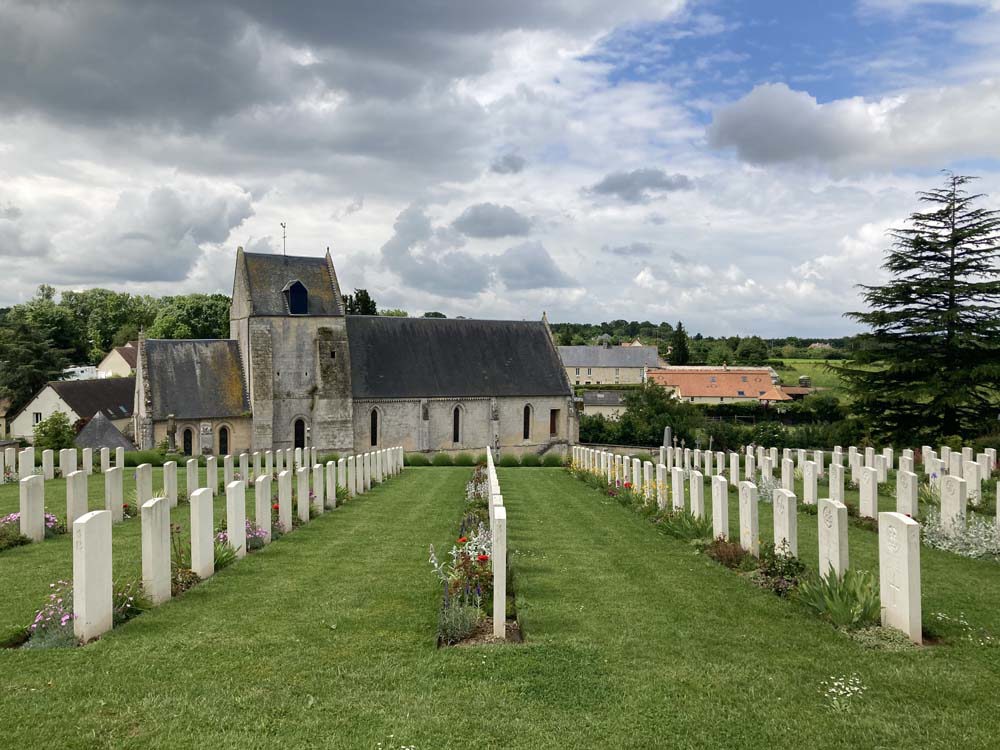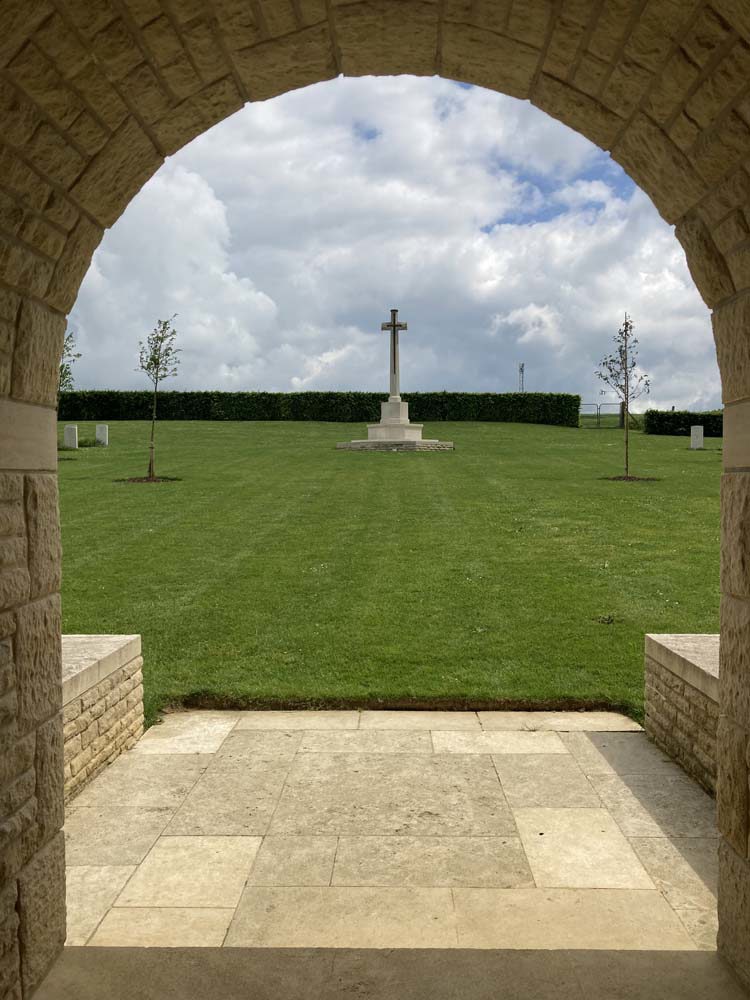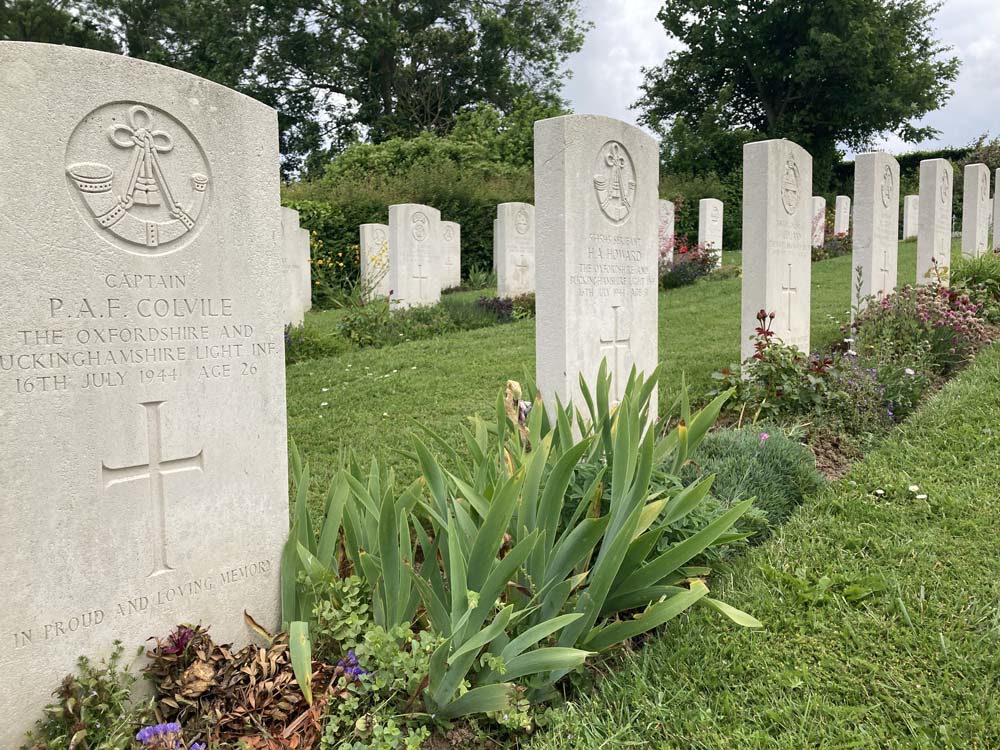28 May 2024
Lesser-known D-Day sites to visit
Taking a trip to Normandy? Read our guide on lesser-known D-Day sites to visit on your trip.
Must-see D-Day sites
D-Day landing sites

Image: Pegasus Bridge at the Pegasus Bridge Museum (Wikimedia Commons)
While the amphibious beach landings dominate the D-Day story, it begins inland with the airborne assault.
British, Canadian, and American paratroopers and glider-borne troops were dropped in the early hours of June 6, 1944, behind enemy lines.
Their job was to capture important canal and river crossings, knock out German artillery batteries, and generally prepare the way for the beach landings later in the morning.
The locations were the paratroopers and glider-borne forces landed were some of the first D-Day sites to see combat.
The Commonwealth soldiers were dropped to the east of the Allied landing zones.
The capture of the bridges over the River Orne and Caen Canal by the Ox & Bucks Light Infantry was one of the first successful D-Day attacks.
Landing by Horsa glider almost directly on top of their objective, the British airborne troops captured both bridges in just 10 minutes. They were able to hold them against counterattack until relieved by troops from Sword Beach.
The bridge over the Caen Canal was renamed Pegasus Bridge after the winged-horse emblem of the Parachute Division.
Another D-Day landing site to visit linked to the Commonwealth airborne assault is the Merville Battery.

Image: One of the casemates at the Merville Battery (Wikimedia Commons)
The Merville Battery was a major German artillery installation overlooking Sword Beach containing four heavy guns.
On the morning of D-Day, it was targeted by the 9th Parachute Battalion under the command of Lieutenant-Colonel Terence Otway.
Unfortunately, the British paratroopers had been scattered across Normandy. From a force of around 700, Otway was only able to assemble 150 lightly equipped paratroopers facing an entrenched enemy position.
The attack went ahead, nonetheless. What followed was a bloody attack but with the element of surprise, the 9th was able to take the battery after 20 minutes of furious action.
The cost was high. Of the 150 British paratroopers attacking Merville, 50 men and officers were killed and a further 25 wounded.
Ranville War Cemetery and Ranville Churchyard are interesting D-Day sites to visit. They hold some of the earliest casualties of D-Day.
A purpose-built Commonwealth War Graves war cemetery, Ranville War Cemetery holds over 2,300 Commonwealth burials and over 300 German war graves.
Ranville Churchyard holds close to 50 Commonwealth casualties, killed during the early hours of D-Day.
D-Day beach sites

Image: Gold Beach as it is today. The remnants of the massive Mulberry floating harbour lie in the water to this day.
The most evocative D-Day sites are probably the landing beaches themselves.
On the morning of June 6, 1944, thousands of Allied soldiers hit the beaches under Operation Overlord: the Allied invasion of Normandy.
Five landing beaches were chosen, split between British, Canadian, and American forces:
- Gold – British
- Sword – British
- Juno – Canadian
- Utah – American
- Omaha – American
For many, Omaha Beach is their favourite D-Day site to visit. Omaha was the bloodiest beach, where over 2,000 American GIs were killed.
The famous opening scene from Simon Spielberg’s Saving Private Ryan has made Omaha one of the most enduring battles in the public imagination.
But this does a disservice to the British and Canadian soldiers fighting their way ashore on Gold, Sword, and Juno. These were by no means walkovers. Juno was particularly bloody, with the Canadians losing 30% of their landing craft before even reaching the shore.
Today, the beaches of Normandy are some of the most popular tourist attractions in Northern France.
The remnants of German Atlantic Wall defences, including concrete bunkers and the remains of gun emplacements, can still be seen. For example, the remains of one of the enormous Mulberry floating harbours built by the Allies still lie off Gold Beach at Arromanches.
The beaches are easily accessible today and free to the public. A road and public transport network serves Normandy, so getting to and from them is easy.
It’s worth noting that the Normandy Beaches stretch across 50 miles of coastline. You may not be able visit them and all the museums and points of interest Normandy has to offer in just one visit.
D-Day launch sites
Operation Overlord, and the naval component of the Normandy Invasion Operation Neptune, were launched from ports along the English coast.
7,000 ships, boats, and landing craft, predominantly Royal Navy vessels, were assembled into a massive flotilla. They carried in their hulls over 150,000 soldiers assembled for the beach assault, as well as their guns, tanks, food, equipment, and ammunition.
By the end of the Normandy Campaign, the Royal Navy had transported over 2 million troops, 3 million tons of supplies and equipment, and 400,000 vehicles to France.
D-Day sites to visit in the UK include the embarkation ports:
- Southampton, Hampshire
- Portsmouth, Hampshire
- Portland, Dorset
- Plymouth, Devon
The majority of Commonwealth troops involved in the D-Day Landings left via Southampton. A steady stream of men left the embarkation ports as the Battle for Normandy continued.
Today, the southern coast of England is littered with sites that are related to D-Day. The D-Day Story Museum has an interactive map detailing some of the most significant UK D-Day sites.
D-Day Sites of Remembrance
Amongst the most important D-Day sites are those that commemorate the dead of the battle. Alongside these sit D-Day war memorials and cemeteries commemorating all the Battle of Normandy’s fallen.
The Commonwealth War Graves Commission maintains many constructed sites in Normandy, including war memorials and cemeteries. Within lay D-Day war graves as well as burials from the wider Normandy campaign.
Here's a selection of CWGC sites that tell the story of Operation Overlord and the fight to liberate northern France.
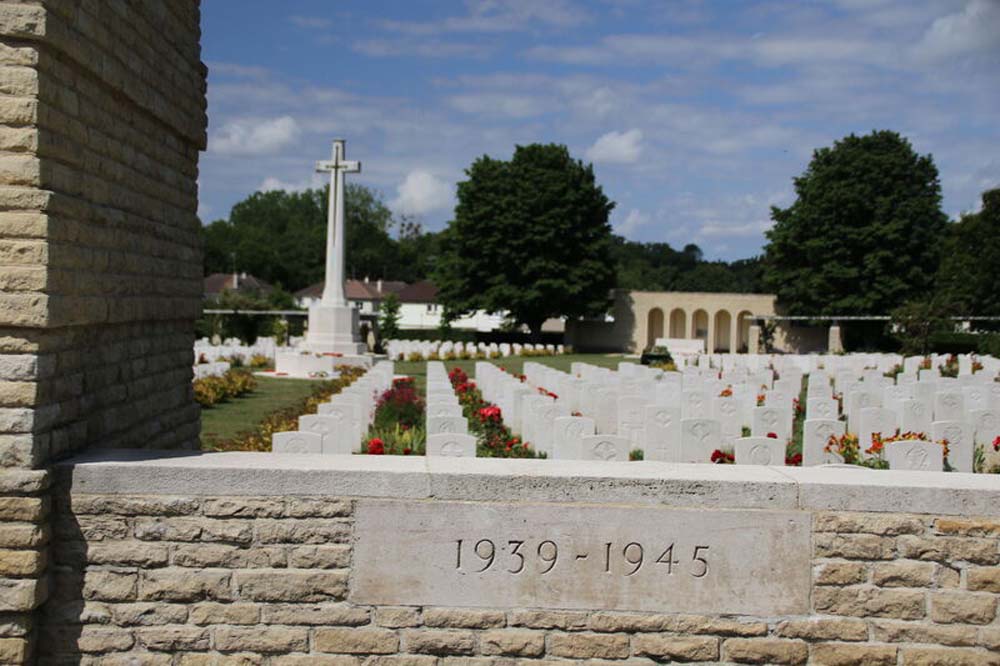
Ranville War Cemetery
As touched on earlier, Pegasus Bridge was one of the key battles of the Normandy Invasion’s early stages.
The village of Ranville, close to Pegasus Bridge, was one of the first villages to be captured by the Allies on D-Day.
It now holds one of the largest CWGC war cemeteries in Normandy, holding 2,500 war graves.

Hermanville War Cemetery
Hermanville War Cemetery lies less than a mile from Sword Beach.
Just over 1,000 war graves can be found at Hermanville. Nearly all of the soldiers buried here were killed in the early days of June 1944.

Bayeux War Cemetery
Bayeux was spared from most of the fighting in Normandy, but it was one of the earliest towns to be liberated.
Bayeux War Cemetery is the largest CWGC cemetery in Normandy, holding over 4,100 Second World War graves.
The Bayeux Memorial commemorates by name a further 1,800 Normandy casualties who have no known war grave.
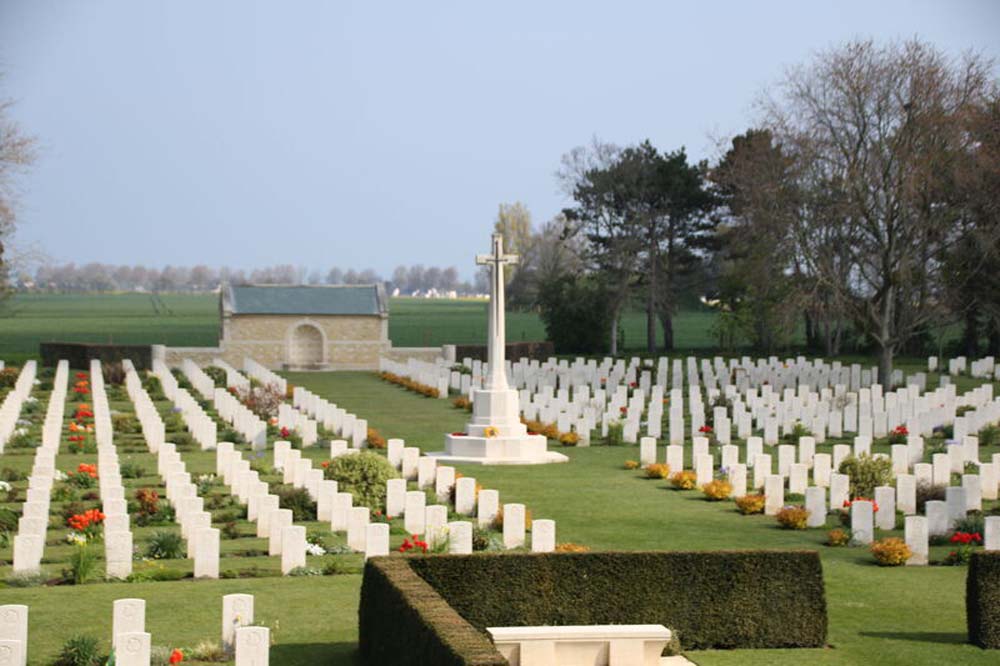
Beny-sur-Mer Canadian War Cemetery
Some 2,000 Canadian servicemen are buried at Beny-sur-Mer Canadian War Cemetery. It lies some two miles inland from the Normandy beaches, near the village of Reivers.
Most of the men buried here were killed during the assault on Juno Beach, or in the advance on Caen. Caen was an important transport hub and the site of much bitter fighting in the summer of 1944.
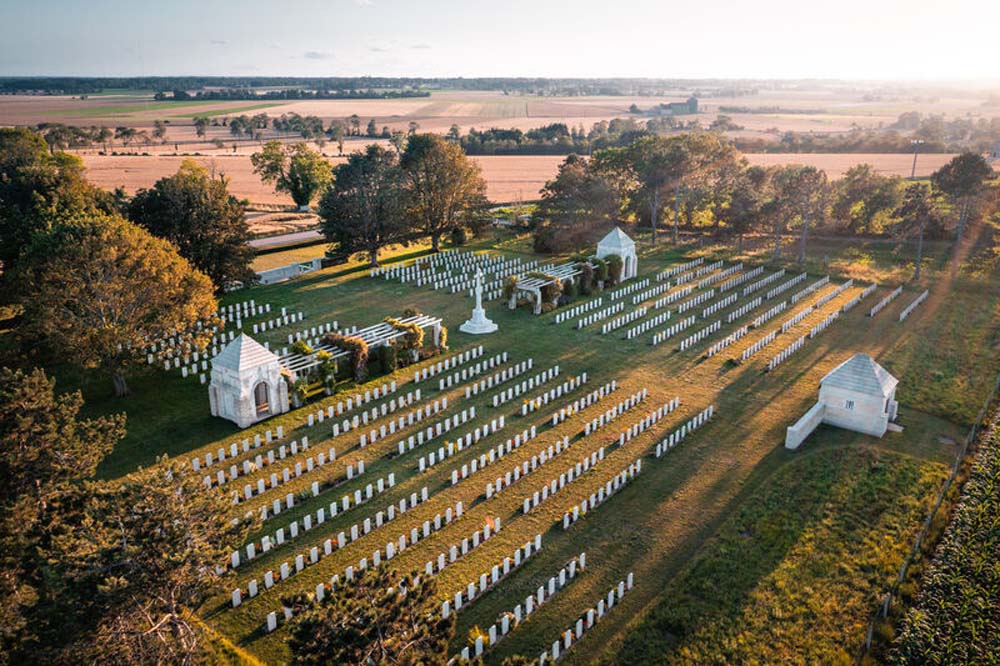
Ryes War Cemetery
Located a little way inland from Gold Beach, Ryes War Cemetery lies in the village of Bezanville. The first burials came in the days after D-Day when casualties were moved off the beach at Arromanches.
Over 650 Commonwealth burials sit within Ryes War Cemetery. The site also holds 300 or so German war graves, cared for by CWGC.

La Deliverande War Cemetery
Lying just over a mile inland from Sword Beach.
Those buried within died across the length of the Normandy Campaign, either on Sword Beach on D-Day morning, or in the thrust to Caen.
Overwhelming British, the cemetery also contains several German, Australian, Canadian, and Polish war graves.
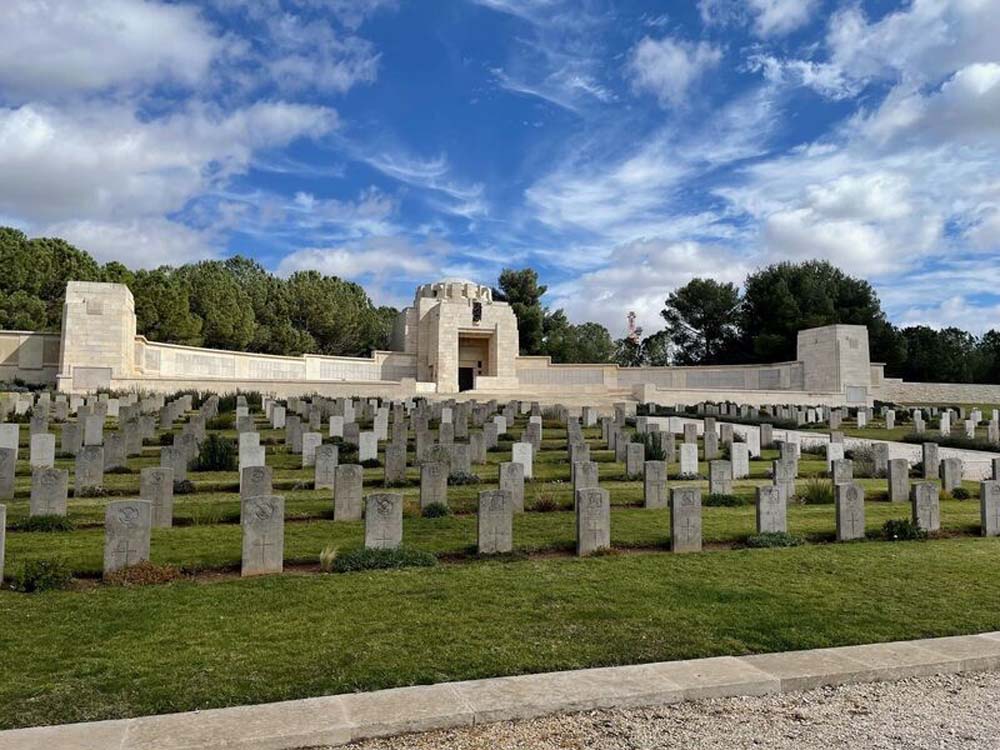
Jerusalem War Cemetery
48 WW2 war graves lie within Jerusalem War Cemetery.
The youngest casualty of the Normandy Campaign, Private Jack Banks, is buried here. He was just 16 years old when he was killed in action in a defensive action against a determined German counterattack at Caen.

St. Manvieu War Cemetery
St. Manvieu War Cemetery on the outskirts of Caen, just a stone’s throw from Carpiquet Airport – a key objective for Allied forces, and determinedly defended by the German army.
While there are burials in this cemetery as early as D-Day itself, the majority of the fallen here died between the end of June to mid-August, demonstrating the ferocity of the fighting in this region throughout the summer of 1944.
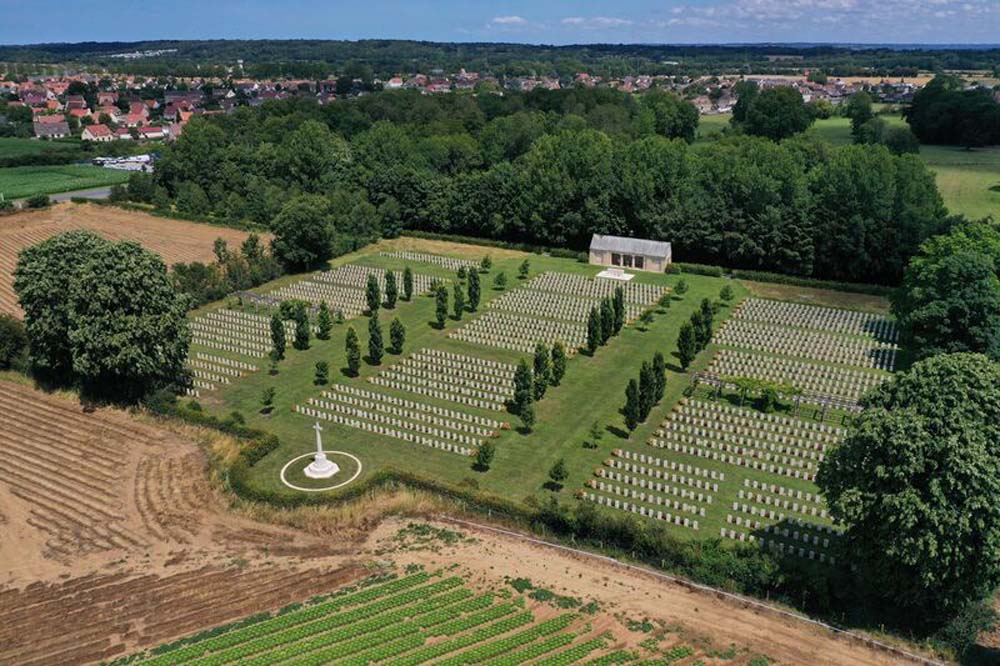
Banneville-La-Campagne War Cemetery
Over 2,000 British servicemen are commemorated at Banneville-La-Campagne War Cemetery, alongside casualties from Poland, New Zealand, Canada, and Australia.
Those buried here were largely killed in July 1944 towards the latter stages of the Normandy Campaign, including the Battle of the Falaise Pocket. The German 7th Army and 5th Panzer Army were encircled and destroyed at Falaise.
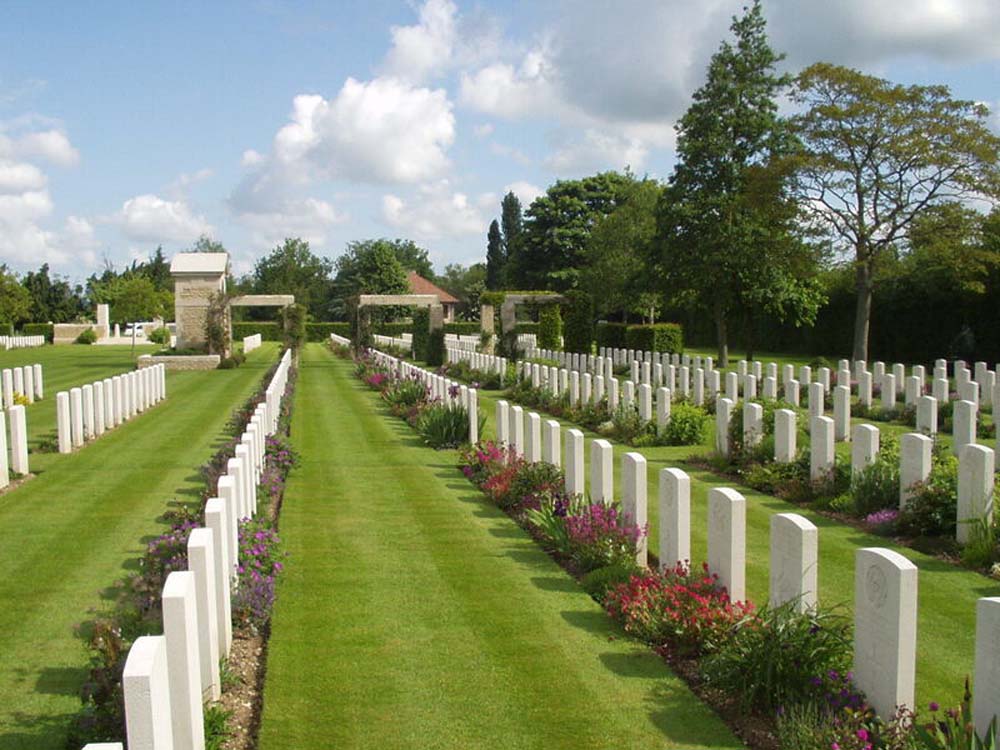
Tilly-sur-Seulles War Cemetery
While Bayeux was one of the first towns to be liberated by Operation Overlord, nearby Tilly-sur-Seulles was a tougher nut to crack.
It was taken on 18 June, the day before the liberation of Caen, but fighting around Tilly continued far into July, resulting in heavy casualties for attackers and defenders alike.
Some 1,000 Commonwealth servicemen are commemorated at Tilly-sur-Seulles War Cemetery. 200 German war graves are maintained here too.
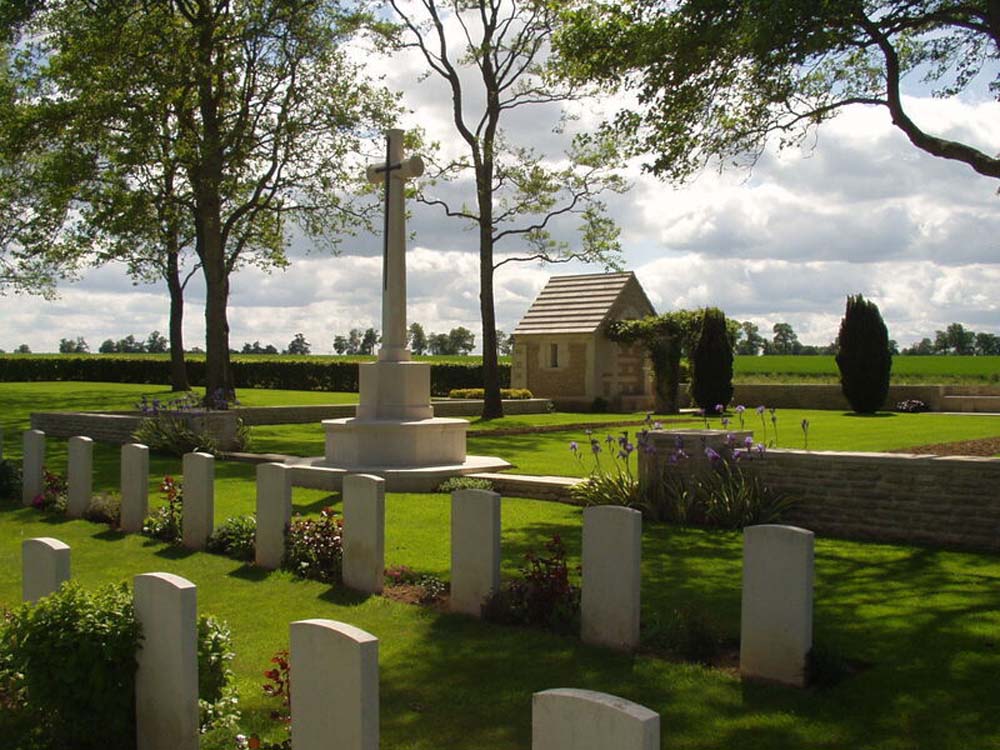
Fontenay-Le-Pesnel War Cemetery
Found to the West of Caen, more than 500 Commonwealth casualties of the Second World War are commemorated at Fontenay-Le-Pesnel War Cemetery.
Most of the men buried here are members of the South Staffordshire, East Lancashire, Royal Warwickshire Regiments, and the Durham Light Infantry.
There are also 4 Canadian burials here, and 57 men of the German Army.
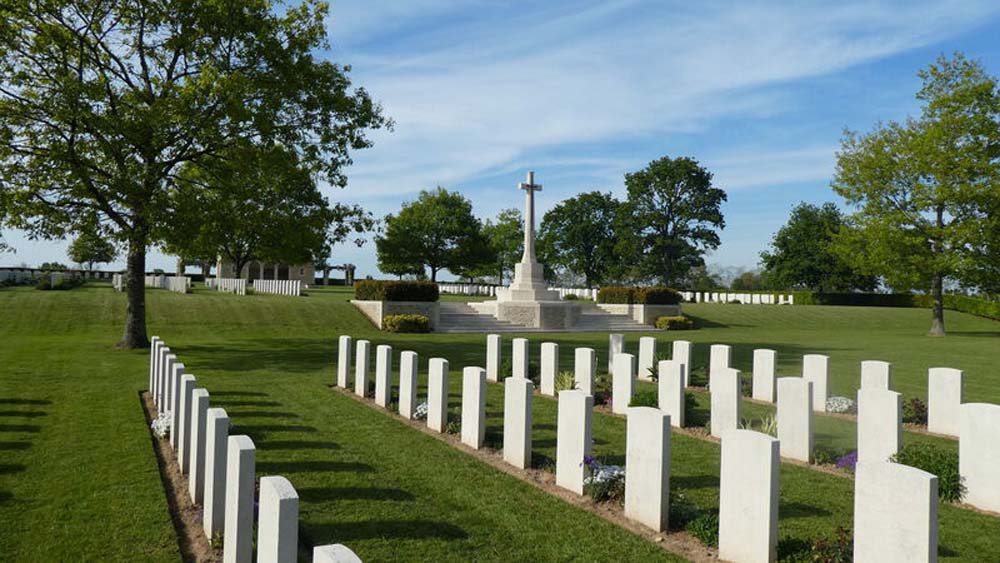
Hottot-les-Bagues War Cemetery
More than 1000 Second World War casualties are buried in Hottot-les-Bagues War Cemetery. Most were killed in June and July of 1944, following the capture of Bayeux and the push towards Caen.
Many of these war dead were killed in sporadic fighting in the region and then moved to Hottot-les-Bagues.
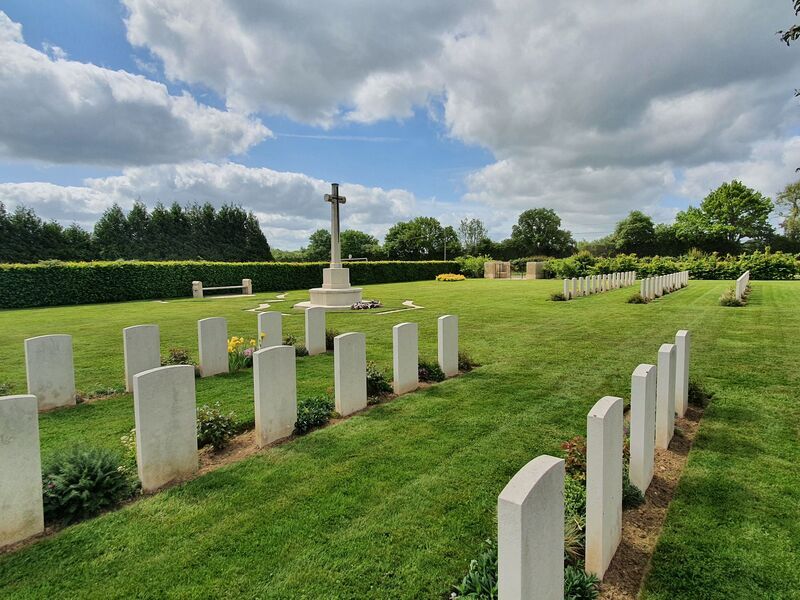
St. Desir War Cemetery
The CWGC cemetery at St. Desir contains close to 600 WW2 burials, with around 450 who were killed in August 1944 in the fighting around the Falaise pocket towards the end of the Battle of Normandy.
Adjacent to the cemetery is the Saint-Désir-de-Lisieux German war cemetery, which contains 3,735 German burials of the Second World War. Begun by the British in August 1944, this cemetery is now under the care of our German sister organisation the Volksbund Deutsche Kriegsgräberfürsorge.
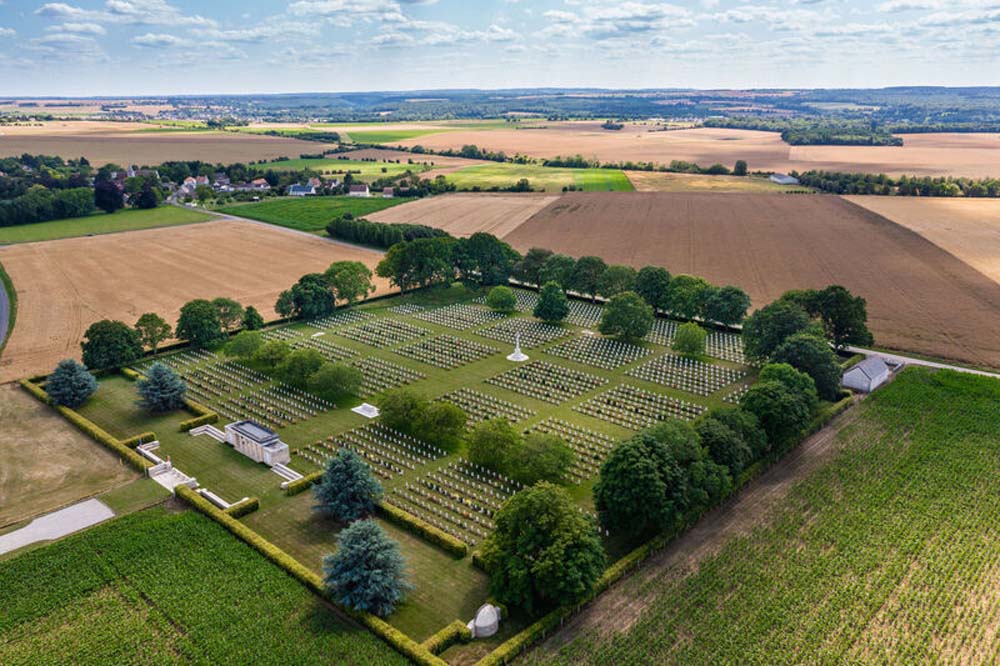
Bretteville-sur-Laize Canadian War Cemetery
Bretteville-sur-Laize Canadian War Cemetery is one of the largest CWGC sites in the Calvados department. Located a few miles south of Caen, the cemetery contains close to 3000 World War Two casualties – the vast majority from Canadian regiments.
Caen was a vital objective in the days immediately following D-Day and with many of those commemorated here dying in early June. A larger proportion of the casualties here are from the large Battle of Normandy and the thrust south by Allied forces.

St. Charles de Percy War Cemetery
The St. Charles de Percy war cemetery is one of the most southern of our Normandy cemeteries. More than 800 Second World War casualties are buried here, predominantly from Operation Bluecoat in August 1944.
Operation Bluecoat was an attack by British forces from the Caumont region towards Vire, with the added benefit of disrupting German forces in the area, preventing an organised counter-offensive, by driving a wedge between the German 7th Army and Panzer Group West.
To mark the 80th anniversary of D-Day, the final leg of the Lighting Their Legacy will see us light every grave in Normandy in the Great Vigil: a moving tribute to the fallen of Normandy.
The Best D-Day Sites in Normandy (according to our expert)
Lynelle Howson, one of our many brilliant CWGC historians, recommends a Normandy site that might have flown under your radar.
Brouay War Cemetery
“Looking for a lesser-known CWGC cemetery in Normandy to visit? A little off the beaten track, Brouay War Cemetery is a little gem. We care for the graves of 377 servicemen there, making it one of our smaller war cemeteries in Normandy.
“Tucked behind this Norman village’s church is a beautifully laid out home for Commonwealth soldiers who died in this area in June, July and August 1944. Our entrance feature echoes medieval Norman stone architecture, taking visitors from the village churchyard via a staircase, up and around, to be welcomed by CWGC’s iconic Cross of Sacrifice.
“Today’s cemetery was created by bringing many graves here after the fighting moved away. But at its heart, this is one of the few remaining original ‘Divisional’ cemeteries from the Normandy campaign. Men of the 53rd Welsh Division of the British Army laid their fallen comrades to rest here from the end of June 1944.
"Over 230 men – 2/3rds of those we now remember here -- died while serving with this division, including nearly all of those buried in Plot III. Two of these men were CANLOAN officers – Canadians serving with British units.
“When you visit, you will see many headstones in Plot III bearing the stringed bugle horn of the Oxford and Bucks Light Infantry. 81 soldiers of the 1st Battalion Ox and Bucks are buried here, 50 of whom died on a single day, 16 July 1944, one small part of the heavy fighting of June-July when Commonwealth forces attempted to encircle Caen to the south.”
D-Day sites map
Museums & educational centres
The Commonwealth War Graves Commission does not operate any visitor centres or museums in Normandy. Our focus here is on the continued commemoration of the war dead, which involves year-round care of the war cemeteries, memorials and war graves in our care.
However, many charitable trusts and other organisations run museums on or close to the D-Day beaches. As you’d expect, they’re among the most popularly visited D-Day sites and are major tourist Attractions.
Juno Beach Centre
Located at Courseulles-sur-Mer, the Juno Beach Centre is focussed on the Canadian forces’ experience on D-Day and beyond.
The centre is run by the Juno Beach Centre Association, which aims to educate the public on Canada’s contribution to the Normandy Invasion.
American Gold Beach Museum
A dual museum, the American Gold Beach Museum has exhibits sharing the story of the British assault on Gold Beach.
The American aspect actually refers to a pre-war event: the first attempt to establish an air-mail link between France and the United States, resulting in the American plane crash landing on the beachfront.
The American Gold Beach Museum is located in Ville-sur-Mer, Normandy.
Le Grand Bunker Museum of the Atlantic Wall
Formerly a 52-foot tall concrete tower built to defend against seaborne invasion, Le Grand Bunker Museum of the Atlantic Wall is entirely dedicated to the German coastal fortifications.
The bunker itself was a former Command and Fire Direction Post, used to coordinate artillery fire by German forces on D-Day. It’s now a fully renovated museum full of documents and photographs detailing the Atlantic Wall and its construction.
The D-Day Story
The D-Day Story is the only British museum dedicated to D-Day and Operation Overlord.
Located in Portsmouth, one of the embarkation ports for troops destined for France, the museum goes through the entire campaign.
The D-Day Story also Landing Craft Tank 7074: the only surviving landing craft to take part in the D-Day invasion. The craft has been comprehensively restored after living a colourful post-war life, including a spell as a floating nightclub.
Areas of Historical Interest

Image: The British Normandy Memorial
Normandy was a major battlefield during the summer of 1944. As such, lesser-known areas of historical interest can be found off the beaten track.
Here are some lesser-known D-Day sites you might want to explore on your next trip to Normandy.
British Normandy Memorial
Overlooking Gold Beach, The British Normandy Memorial is one of the latest memorials to the dead of Normandy.
This is not a Commonwealth War Graves Commission Memorial, however we are caring for it on behalf of the Normandy Memorial Trust.
Opened on June 6, 2021, 77 years to the day after the Invasion of Normandy, the Memorial commemorates over 22,000 British service personnel who killed during the Battle of Normandy.
1944 Radar Museum
Situated in the Canadian sector, the radar installation at Douvres-la-Délivrande is a unique piece of Second World War history.
A German radar dish, the Wehrmacht used it to scan the Normandy skies for Allied aircraft. The museum shows a 1944-era radar plus information on how it was captured.
The D-Day Academy
One of the more unusual ways to tour D-Day sites comes with the D-Day Academy.
The Academy maintains a fleet of vintage period vehicles, including lots of trucks and even an amphibious troop carrier, taking tourists to key D-Day locations. Historians and D-Day paraphernalia are on board, turning Normandy into an open-air museum.
Key towns & cities
Bayeux was the first major town to be liberated during WW2's Operation Overlord. It is the site of the largest CWGC cemetery in Normandy.
Caen was the subject of horrendous fighting throughout most of the Battle for Normandy. It was an objective on D-Day, but it took over six weeks and hunreds of thousands of Commonwealth soldiers to capture.
The seaside town of Arromanches is connected to Gold Beach. It lay at the western edge of the landing zone. Sword Beach stretches for 8 kilometres of Normandy coast between Lion-sur-Mer in the west and Ouisteham in the east.
Juno Beach, situated between Gold to the west and Sword to the east, covers a 10-kilometre front, stretching along the small fishing port of Courseulles-sur-Mer.
Start your Normandy D-Day Adventure

Lighting their Legacy
Across the UK, May & June
Discover our national programme of events and inspire the next generation.
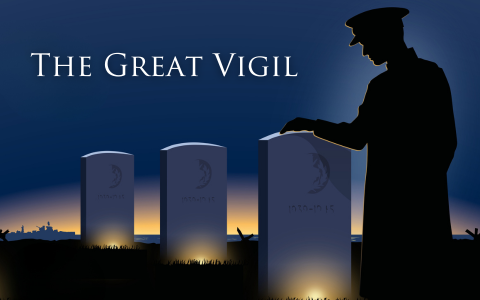
The Great Vigil
Normandy, 5 June
Join the culmination of our D-Day events as we illuminate every CWGC grave in Normandy.
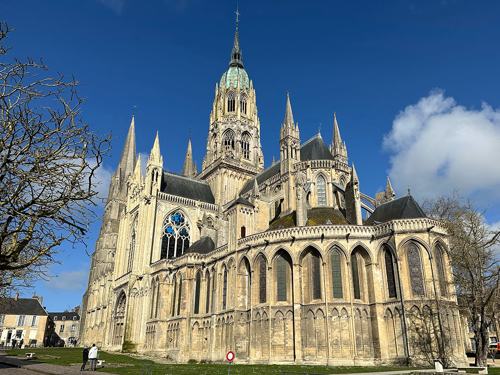
DISCOVER OUR 80TH ANNIVERSARY WW2 EVENTS
We're holding a number of events across the UK and in Normandy in the build up to the 80th anniversary of D-Day. Find out more about what we're planning and discover how you can get involved.
Find out more

